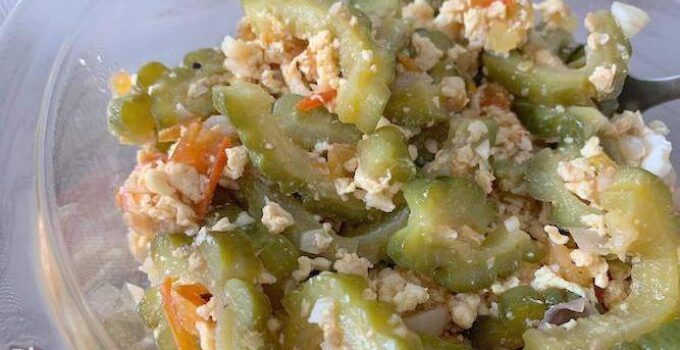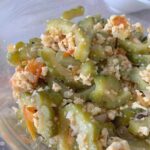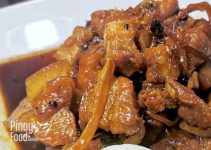Ginisang Ampalaya~ a simple yet tasty vegetable dish that’s not only packed with nutrients but is really easy and affordable to make!
For me, ginisang ampalaya (sauteed bitter gourd) is one of those dishes you hated as a kid, but learned to love while growing up. It is a perfect pair to many Filipino fried and grilled dishes, and that’s why it’s worth learning this dish.
In this recipe article, you’ll learn everything you need to know about this dish, especially how to reduce the bitter taste. I recommend you read through the article before jumping to the recipe.
What is Ginisang Ampalaya?
Ginising Ampalaya directly translates to Sauteed Bitter Gourd (Bitter Melon). In this dish, ampalaya is sauteed with garlic, onion, and tomatoes, then later mixed with scrambled eggs. Its taste could be described as generally bitter and savory.
In this recipe, we will be sharing with you the most basic form of this dish. However, you may opt to add-in some type of meat to this dish. We will be sharing some meat suggestions as well.
What is Ampalaya
To better understand this dish, let’s take a look at the main ingredient- ampalaya.
Ampalaya (or Bitter Melon/Gourd) is a locally grown vegetable in the Philippines. Several varieties of this vegetable come in different shapes and sizes, but in the country, it has a long cylindrical shape that looks like a wrinkled cucumber.
It is a common ingredient used in Asian and Filipino cuisine. You’ll find ampalaya in some Ilocano dishes like Pinakbet and Dinengdeng.
Health Benefits of Ampalaya
It is also common knowledge that ampalaya is highly nutritious and is probably the reason why we still eat them despite the bitter taste. It is traditionally used to treat diabetes and it includes tons of macro and micro nutrients that’s vital for cardiovascular health.
How to Reduce Bitterness of Ampalaya?
One main concern when cooking ampalaya is to somehow reduce the bitterness level. You know you’re eating a good ampalaya dish when the bitter taste is not that strong. Here are several techniques that you can try:
- Pick up young ampalaya when buying in the market. Avoid mature looking ones, especially the ones that are already changing in color.
- When preparing the ampalaya, do your best to trim off the inner parts that include the seeds and the white pith. Reducing the rough outer surface of the vegetable can also help remove the most bitter parts.
- Don’t overcook the ampalaya. The longer it takes to cook, the more bitter the vegetable gets. Cooking this must not take long, we also want it to still be crisp when eating.
- You can also add a little sugar in the dish to help balance out the bitter flavors. Remember not to add too much since we don’t want to alter the overall taste of the dish.
- Salting is the most common technique used when removing the bitterness. The salt helps release the bitter juices from the vegetable. We will be sharing 2 ways to do this in this recipe.
Ingredients You’ll Need
Aside from ampalaya, we will also be using other regular pantry ingredients like onion, garlic, tomato, eggs, salt, black pepper, and cooking oil. If you are filling up your pantry, here’s a handy shopping guide:
Equipment You’ll Need
- Cooking Pan (Kawali)- You will need a regular cooking pan or kawali to cook this dish. It depends on the amount you’ll be cooking but a frying pan or skillet will also work for this.
In need of kitchen tools and equipment? Read this before you buy:
How to Cook Ginisang Ampalaya
We will be dividing the whole process of cooking ginisang ampalaya into two parts. First is the salting part and second is the cooking part.
Salting the ampalaya is an important step so we could tone down the natural bitter taste and make it more pleasant to eat. There are actually 2 common ways to do this.
The first one is where you directly toss the ampalaya slices by hand with the salt and rinse it afterwards. The other one involves soaking the ampalaya slices in a salt solution then draining and rinsing afterwards.
You can pick any of the two techniques as both serve the same purpose.
Next is the cooking part and it is pretty simple and straightforward. We just start off with the aromatics, then cook the ampalaya with them for a few minutes. We then add-in the eggs and scramble them with the rest of the ingredients.
To further improve your cooking skills when it comes to this dish, try the tips below.
Cooking Tips
- Don’t overmix the ampalaya when sauteing. A few tossing and stirring will do to prevent the ampalaya from getting more bitter.
- Undercook the eggs. When adding the eggs on the last part, just wait for it to set before mixing them with the other ingredients. This will make the eggs fluffier and tastier. Don’t worry, residual heat in the dish will eventually cook the eggs through.
How to Serve Ginisang Ampalaya
What is the best partner for ginisang ampalaya? This dish is best served with white rice and usually another savory dish like pork adobo or grilled dish like inihaw na liempo.
As mentioned earlier, you can also incorporate meat while cooking this dish. The most common would be shrimp, canned sardines, or flaked fish. But this dish is really flexible as you can also cook it with other meat like pork, chicken, beef, or even squid.
How to Store and Reheat Ginisang Ampalaya
When you have leftover ginisang ampalaya, store it in a clean covered food container. You can place them in the refrigerator and consume within 2 to 3 days. To reheat, you can either use a microwave oven or over a stovetop using low to medium heat.
Other Vegetable Recipes
For a quick reference about this recipe, see the recipe table below:
Easy Ginisang Ampalaya Recipe
Equipment
- Cooking Pan
Ingredients
- 2 pcs medium-sized ampalaya (bitter gourd), cleaned, seeds and pith removed, and cut into thin slices
- 2 pcs eggs, beaten
- 2 pcs large-sized tomato, sliced
- 1 pc medium-sized onion, sliced
- 3-4 cloves garlic, minced
- 1/4 cup water
- 2 tbsp cooking oil
- 1/2 tsp ground black pepper
- salt, to taste
Instructions
- First, we will reduce the bitterness of the ampalaya by salting it, you have 2 options:
Ampalaya Preparation Option 1
- Place the ampalaya slices in a bowl. Directly add about 2 tbsp of salt to the ampalaya.
- Toss the ampalaya with the salt by hand.
- Wash away the salt then drain after.
Ampalaya Preparation Option 2
- Fill a bowl with enough lukewarm water to cover the ampalaya. Add-in about 2 tbsp of salt and mix.
- Add-in the ampalaya slices and soak for 10 to 20 minutes.
- Drain and rinse after.
Cooking Instructions
- While preparing the other ingredients, place the ampalaya slices in a bowl with cold water.
- In a cooking pan, pour-in the oil then apply heat.
- Add-in and saute the garlic, onion, and tomatoes. Cook until the onion is soft and the tomatoes become mushy.
- Add-in the water then bring to a boil.
- Add-in the ampalaya slices and toss gently. Cook for 2 to 3 minutes or until tender but still crisp.
- Add-in the beaten eggs then pour-in to the pan.
- Allow to partially cook then stir them with the other ingredients.
- Remove from heat and transfer to a serving plate. Serve and enjoy!
Notes
Nutrition
Pin and save this recipe to your Pinterest account! Click on the Pin button above 🙂
Thank you and I hope you find this article useful! It’ll mean a lot if you RATE THE RECIPE by clicking the stars and SHARE THIS TO YOUR FRIENDS! 🙂




